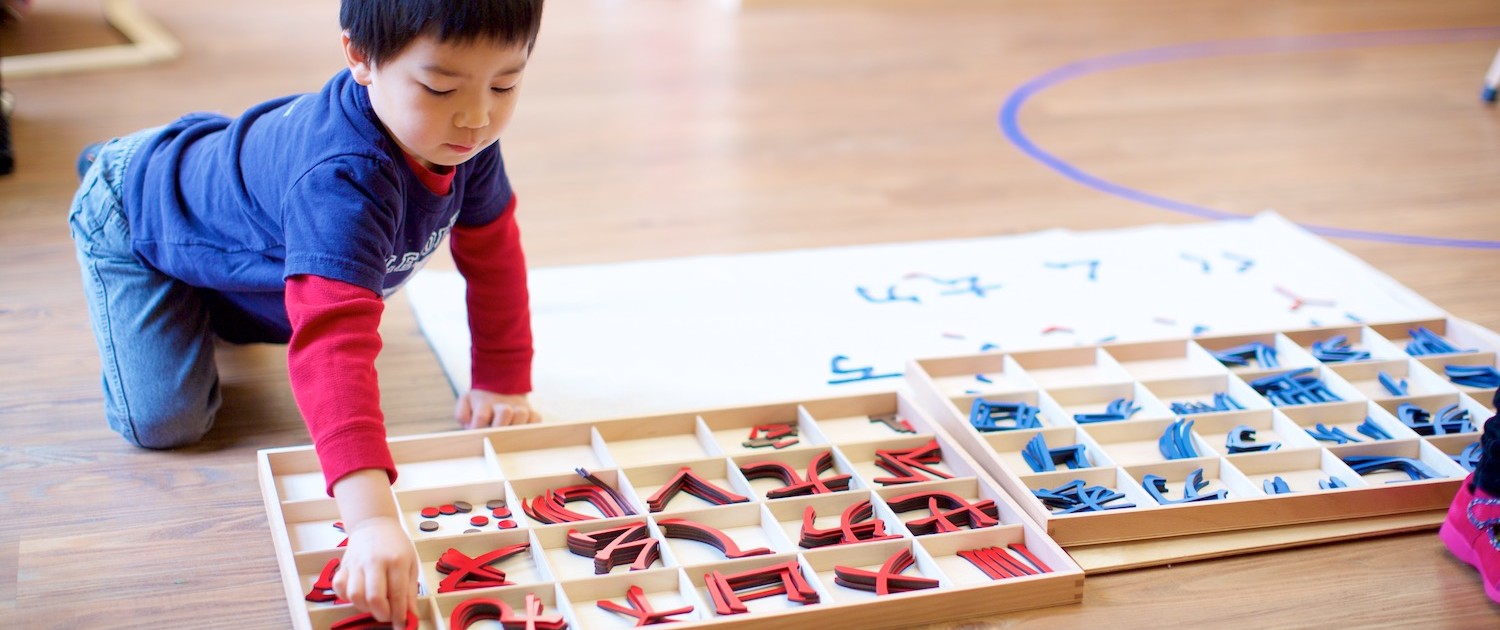The Mandarin immersion program is an authentic Montessori program for toddlers and preschool/kindergarten. The only difference to the English program we offer at our other Irvine campuses is that this program is primarily taught in Mandarin Chinese.
- A full Montessori environment. Our Mandarin immersion programs for toddlers and preschoolers are authentic, high-quality Montessori programs. Children are guided by AMI-trained Montessori teachers as they work with a full range of Montessori learning materials. Just like in our English-language programs, children have time to deeply engage with the learning activities in their classrooms. They thrive in a mixed-age environment, where they interact with their peers and develop strong social skills.
- Taught in Mandarin Chinese. In both the toddler (ages 18 months – 36 months) and preschool class (ages 3 – 6 years), both teachers in the classroom are native Chinese speakers and will speak only in Chinese with the children and with each other.
- A full immersion approach with a goal of full bilingualism. Our goal is to help children achieve full bilingualism—understanding, speaking, writing and reading—in their two languages. That’s why we have chosen a full immersion approach. Children will be surrounded by Chinese: the teachers are speaking with them in Chinese; they are singing Chinese songs and reading Chinese stories; they are surrounded by Chinese culture, from big celebrations like the Chinese New Year, to little touches like Chinese art and practical life activities in the classroom. Because all interactions are in Chinese, even children who do not know any Chinese pick up the language and learn to not just understand, but also speak it.
- Traditional Chinese characters and Zhuyin for reading and writing. Our Chinese literacy curriculum is based on traditional Chinese characters and Zhuyin (or Bopomofo). You can read the full rationale for choosing this approach in the Mandarin Immersion FAQ. With the Zhuyin phonetic system, children can learn to read and write Chinese phonetically starting at age three or four, in parallel with learning to write and read in English.
- English writing and reading introduced starting at age three. Once a child joins our English preschool program, she will have regular instruction in English writing and reading by a Montessori trained English-speaking teacher. This ensures that even while the child learns to speak in Chinese, she is still able to work on her English writing and reading skills during the early sensitive period for language.
Eligibility
We enroll children between the ages of 18 months and 3 ½ to 4 years at our Irvine Mandarin location.
Our Mandarin Immersion Montessori programs are designed for children who have some English language background at home: At least one parent should be able to speak English at home, and commit to speaking and reading in English daily with your child at home, especially if your child is an infant or toddler and has limited exposure to English in the community.
We welcome children with Chinese knowledge into the program. Just note that our Mandarin Immersion programs are not designed for native Mandarin-speakers who will not be able to learn English outside of school; those children may be better served in our English-language Montessori classrooms, where they can complement their strong Mandarin skills from home with English language skills. If you only speak Mandarin at home, one option to consider is starting your child in our English infant or toddler program, to give your child a strong grounding in English. Then, when your child turns three, she can move on into the Mandarin immersion track. In either case, we encourage you to meet with a LePort Head of School, to discuss your family’s unique circumstances, and to develop a plan that is tailored to your child’s needs.
Our Mandarin immersion program is designed to include the full three-year Montessori cycle in mind; that is, it extends until your child has reached the age of 6 (this includes the traditional kindergarten year). This ensures that your child is in the Mandarin immersion program long enough to acquire not only strong Mandarin skills but also to learn the fundamentals of English literacy. Since the first few years focus strongly on Mandarin language skills, it’s important to stay for the 3rd program year (kindergarten), where we invest significant time in English written language skills.


